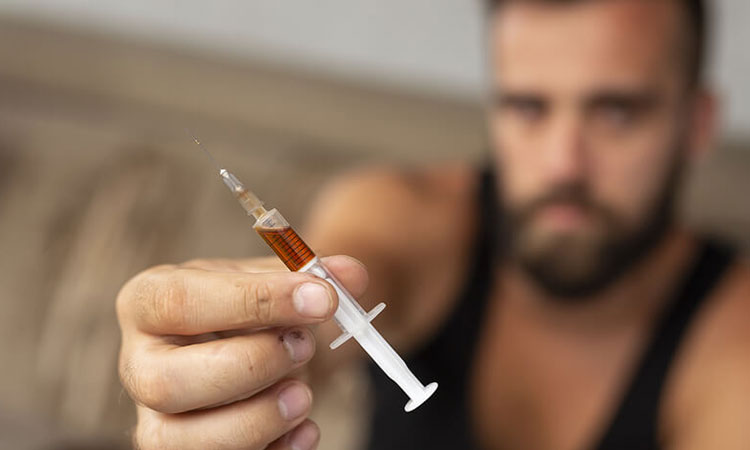
When a person shoots heroin, track marks, which are essentially scars, begin to develop around an injection site. Prolonged and repeated use at the same site increases the risk of a track mark forming. Injecting heroin intravenously is also called shooting.
When heroin is injected into a vein, its effects onset more rapidly and intensely than ingestion by other methods such as snorting or smoking.
Peak opioid effects occur within just seconds after administering the drug, but the duration of effects that result from this type of use are shorter-lived than with other methods.
When heroin is injected, use can also cause sores, abscesses, and holes at the injection sites. In severe cases, veins collapse from excessive use, increasing the chance that a needle will be injected into a muscle instead. This mishap can result in other complications, such as fibrous skin lesions around injection sites.
Recognizing Heroin Use
There is unique paraphernalia related to this type of heroin use, including hypodermic needles, cotton balls, or a spoon for liquefying the drug. Heroin injectors also use something that can function as a tourniquet and be wrapped around an extremity, such as a rubber band or piece of cloth, used to make the vein more obvious.
In addition to track marks, injection increases the risk of other serious complications. Because heroin also often contains adulterants and toxins, this can result in residue in the blood vessels upon injection. This buildup of toxic residue can induce damage to the brain, lungs, kidneys, and liver.
As noted, there are different ways heroin can be administered. Snorting or smoking is also popular among users, but, ultimately, many people who start out ingesting the drug in these ways advance to injecting it for the more intense high it provides.
Without a doubt, any use of heroin is dangerous, but intravenous use comes with the most risks by far. Heroin track marks are the scars that remain long after someone has shot up heroin or another drug, and they are often the result of chronic drug abuse in the same spot over and over again.
What Do Heroin Track Marks Look Like?
Recently developed heroin track marks appear as fresh lesions, and they resemble a standard puncture wound. They may also present as bruises or scabs. Most often, heroin marks manifest in the crook of the arm, but there are other places where heroin track marks may be spotted, including legs, feet, hands, and the groin area.
When heroin marks are found on the arm, they are frequently on the non-dominant arm, because its often easier for the person to administer the drug this way. However, if the person has someone else inject the heroin for them, the track marks could also be on their dominant arm.
Hands and feet have shallower veins and arteries than other areas, and these can be easily damaged, and scarring may be more likely. A person may sustain a lot of damaged or inflamed tissue or collapsed veins in the arms or their preferred injection sites.
At this point, they may resort to injecting in a variety of other locations around the body. People may also choose different places to administer heroin because it allows them to conceal the track marks more easily.
Older heroin track marks may begin to appear as discolored, raised, plague-like scars. Even after someone stops heroin use, scars of track marks may remain indefinitely. In some instances, there may also be infections at the site and ulcerous sores or holes.
Treatment for Heroin Addiction
The presence of track marks are a tell-tale sign of drug addiction and injection, and heroin is the drug that people most often administer in this manner. Heroin addiction is a devastating, life-threatening disease that is best treated by medical addiction specialists in a safe clinical environment.
Recovery By The Sea offers comprehensive treatment for addiction in both partial-hospitalization and outpatient formats. Our programs are designed to meet the unique needs and goals of each client and include research-based services vital to the recovery process, such as behavioral therapy, counseling, group support, and more.
We are dedicated to providing clients with the resources and support they need to achieve a full recovery, prevent relapse, and enjoy long-lasting sobriety and wellness! If you or someone you love is suffering from heroin addiction, contact us today to find out how we can help!
Related: What Is the Mojo Drug?